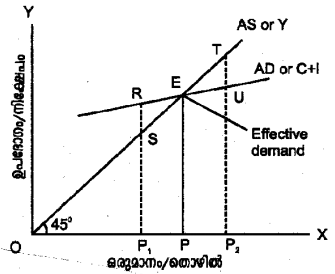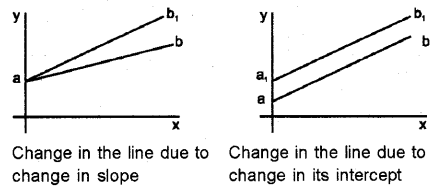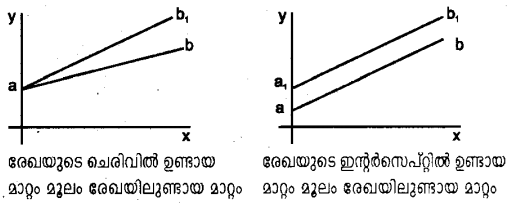Kerala Plus Two Macroeconomics Notes Chapter 4 Income Determination
Income and Employment: Keynesian Approach
It was J. M. Keynes, who proved that the concept of Say’s law of market was practically wrong. The great depression of 1930s and the subsequent economic events confirmed his arguments. Keynes’ ideas were published in his epoch-making book entitled General Theory of Employment, Interest and Money published in 1936. It revolutionized the existing economic thinking. He totally denied the classical concept of full employment. He argued that an economy can reach the equilibrium position even without full employment, which is known as the underemployment situation.
Effective demand is the basis of Keynesian principles. He argued that the level of income and employment in an economy depends on effective demand. Lack of effective demand leads to unemployment. Effective demand is reached at a point where aggregate demand equals aggregate supply.
Aggregate Demand and Aggregate Supply
The level of employment and income in an economy depends on aggregate demand and aggregate supply.
Aggregate demand and its components:
Aggregate demand is the total demand in an economy. It is the total expenditure on various goods and services. The major components of aggregate demand are as follows:
- Household consumption demand
- Private investment demand
- Demand for goods and services by the government
- Net-export demand.
Aggregate Supply:
Aggregate supply indicates the total supply of goods and services in the economy. In other words, it is the net-national product at factor cost of a nation. In terms of money; aggregate supply is the reward received by factors of production in terms of rent, wages, interest and profit.
Determination of Equilibrium Level of Income:
The equilibrium level of income in an economy is determined by the aggregate demand and aggregate supply. The equilibrium level of income is based on income and employment is provided in the chart.

In the above chart, income and employment are indicated in X axis and consumption and investment on Y axis. Aggregate Demand (AD) is indicated with the straight line curve C + I. It is the sum total of consumption expenditure and investment expenditure. The 45° line Y passes through the point O shows the aggregate supply. Here, Y equals C + S. The point at which AD equals AS at point E is called effective demand. At this point, the income and expenditure of the entrepreneurs become equal.
വരുമാനവും തൊഴിലും – കെയ്തീഷ്യൻ സമീപനം (Income and employment – Keynesian Approach)
സേയുടെ കമ്പോള നിയമം പ്രായോഗിമായി തെറ്റാണെന്ന് ജെ. എം. കെയ്ൻസ് തെളിയിച്ചു. 1930 – ലെ വലിയ മാന്ദ്യം കെയ്ൻ സിന്റെ അവകാശവാദത്തെ സാധുരിക്കുന്നതതായിരുന്നു. 1936 – ൽ കെയ്ൻസ് തന്റെ എക്കാലത്തെയും പ്രശസ്തമായ തൊഴിലി ന്റെയും പലിശയുടേയും പണത്തിന്റെയും പൊതു സിദ്ധാന്തം (General Theory of Employment, Interest and Money) എന്ന പുസ്തകം പ്രസിദ്ധീകരിച്ചു. ആധുനിക സാമ്പത്തിക ശാസ്ത്ര ചിന്താധാരയിൽ ഇത് ഒരു വിപ്ലവംതന്നെ സൃഷ്ടിച്ചു. കെയ്നീഷ്യൻ വിപ്ലപം (Keynesian Revolution) എന്നാണിത്അ റിയപ്പെടുന്നത്. പൂർണ തൊഴിലവസ്ഥ എന്ന ക്ലാസ്സിക്കൽ ചിന്താഗതിയെ കെയ്ൻസ് നിരാകരിച്ചു. പൂർണ തൊഴിലവസ്ഥ യിൽ എത്താതെതന്നെ ഒരു സമ്പദ്വ്യവസ്ഥയ്ക്ക് സന്തുലിതാ വസ്ഥ പ്രാപിക്കുവാൻ കഴിയുമെന്ന് കെയ്ൻസ് വാദിച്ചു. പൂർണ തയിലെത്താത്ത തൊഴിലവസ്ഥ (underemployment) എന്നാണ് ഇതിനെ അദ്ദേഹം വിശേഷിപ്പിച്ചത്.
കെയ്ൻസ് സിദ്ധാന്തത്തിന്റെ അടിസ്ഥാനം ഫലപ്രദചോദനം effective demand) ആണ്. ഒരു സമ്പദ് വ്യവസ്ഥയിലെ തൊഴി ലവസ്ഥ അവിടുത്തെ ഫലപ്രദചോദനത്തെ ആശ്രയിച്ചിരിക്കുന്നു വെന്നാണ് കെയ്ൻസ് സമർത്ഥിക്കുന്നത്. ഫലപ്രദചോദനത്തിന്റെ കുറവുകൊണ്ട് തൊഴിലില്ലായ്മ സംജാതമാകുന്നതെന്നാണ് അദ്ദേ ഹത്തിന്റെ സിദ്ധാന്തം. മൊത്തം ചോദനവും മൊത്തം പ്രദാനവും തുല്യമാകുന്ന അവസ്ഥയാണ് ഫലപ്രദചോദനത്തെ നിർണയിക്കു ന്നത്.
മൊത്തം ചോദനവും മൊത്തം പ്രദാനവും (Aggregate Demand and Aggregate Supply)
തൊഴിലും വരുമാനവും നിർണയിക്കപ്പെടുന്നത് മൊത്തം ചോദ നത്തിന്റെയും മൊത്തം പ്രദാനത്തിന്റെയും അടിസ്ഥാനത്തിലാണ്.
മൊത്തം ചോദനവും അതിന്റെ ഘടകങ്ങളും (Aggregate Demand and its Components)
ഒരു സമ്പദ്വ്യവസ്ഥയിലെ സാധന സേവനങ്ങളുടെ ആകെ ചോദ നമാണ് മൊത്തം ചോദനം. സാധനങ്ങളുടെയും സേവനങ്ങളു ടെയും മൊത്ത ചെലവാണ് ഇത്. ഇതിന്റെ പ്രധാന ഘടകങ്ങൾ താഴെപ്പറയുന്നവയാണ്.
- ഗാർഹിക ഉപഭോഗ ചോദനം
- സ്വകാര്യ നിക്ഷേപ ചോദനം
- സാധനങ്ങളുടെയും സേവനങ്ങളുടെയും ഗവൺമെന്റ് ചോദനം
- അറ്റ കയറ്റുമതി ചോദനം
മൊത്തം പ്രദാനം (Aggregate Supply)
മൊത്തം പ്രദാനമെന്നത് ഉൽപ്പന്നത്തിന്റെ ഉൽപ്പാദനത്തിനുള്ള മൊത്തവ്യയം ആണ്. ഇത് ഒരു രാജ്യത്തിന്റെ ഘടകവിലയിലുള്ള അറ്റദേശീയ ഉൽപ്പന്നമാണ്. (Net national product at factor cost) പണത്തിന്റെ അടിസ്ഥാനത്തിൽ പറഞ്ഞാൽ, ഉൽപ്പാദിപ്രകി യയിൽ പാട്ടം, വേതനം, പലിശ, ലാഭം എന്നീ രൂപങ്ങളിൽ ഉൽപ്പാ ദന ഘടകങ്ങൾക്കു ലഭിക്കുന്ന വരുമാനമാണിത്.
സന്തുലിത വരുമാന നിർണ്ണയം (Determination of equilibrium level of income)
ഒരു സമ്പദ്ഘടന സംതുലിതാവസ്ഥയിലാകുന്നത് മൊത്തചോദ നവും മൊത്ത പ്രദാനവും തുല്യമാകുമ്പോഴാണ്. വരുമാനത്തി ന്റെയും തൊഴിലവസ്ഥയുടെയും സംതുലിതാവസ്ഥ നിർണ്ണയി ക്കുന്ന വിധം ചിത്രത്തിൽ കാണിച്ചിരിക്കുന്നു.

ചിത്രത്തിൽ x-അക്ഷത്തിൽ വരുമാനവും തൊഴിലവസ്ഥയും രേഖ പ്പെടുത്തിയിരിക്കുന്നു. y-അക്ഷത്തിൽ ഉപ ഭോഗവും നിക്ഷേപം അടയാളപ്പെടുത്തിയിരിക്കുന്നു. C + I എന്ന രേഖമൊ ത്തചോദനത്തെ സൂചിപ്പിക്കുന്നു. ഉപഭോഗ ചെലവും നിക്ഷേപ ചെലവും ചേരുന്നതാണിത്. എന്ന ബിന്ദുവിലുടെ 45° യിലുള്ള y എന്ന രേഖ മൊത്തപ്രദാനത്തെ സൂചിപ്പിക്കുന്നു. ഇവിടെ y എന്നത് C + S ആണ്. AD രേഖയും AS രേഖയും സംഗമിക്കുന്ന E എന്ന ബിന്ദുവാണ് ഫലപ്രദമായ ചോദനം (effective demand) ഈ ബിന്ദുവിൽ സംരംഭകന്റെ ചെലവും വരവും തുല്യമാണ്.
Ex-Ante And Ex-Post
Consumption, Savings and investment can be classified into Ex-ante and Ex-post variables. The terms Ex-ante and Ex-post have been derived from the Latin word. Ex-ante means planned or desired. Ex-post means actual or realized. In national income accounting, the variables such as consumption, investment and savings are considered as ex-post variables. The rate at which consumption, savings and investment are presented in the ex-post sense.
എക്സ് – ആന്റേ, എക്സ് – പോസ്റ്റ് (Ex-Ante, Ex-Post)
ഉപഭോഗം, സമ്പാദ്യം, നിക്ഷേപം ഇവയെ നമുക്ക് എക്സ് – ആന്റേ, എക്സ് – പോസ്റ്റ് എന്നിങ്ങനെ അവതരിപ്പിക്കാം. എക്സ് – ആന്റേ, എക്സ് – പോസ്റ്റ് ഇവ രണ്ടും ലാറ്റിൻ വാക്കുകളാണ്. എക്സ് – ആന്റേ എന്നാൽ മുൻകൂട്ടി അഥവാ ആസുത്രിതം എന്നും എക്സ് – പോസ്റ്റ് എന്നാൽ ശേഷം അഥവാ യഥാർത്ഥം എന്നുമാണ് അർത്ഥം. ദേശീയ വരുമാനം കണക്കാക്കുമ്പോൾ ഉപഭോഗം, സമ്പാദ്യം, നിക്ഷേപം എന്നിവ എക്സ് – പോസ്റ്റ് ആയി അവതരിപ്പിക്കുന്നു. സമ്പാദ്യ നിരക്കോ, നിക്ഷേപനിരക്കോ, ഉപ് ഭോഗമോ നമുക്ക് എക്സ്- ആന്റ് ആയി പരിഗണിക്കാം. അഥവാ അവ ആസൂത്രണം ചെയ്യാം.
Ex-Ante Consumption
We have already learned that the variables income and consumption are positively related. Even if the level of income is zero, there is a certain amount of consumption for survival. This is known as minimum subsistence level of consumption or autonomous consumption denoted with 7. Its value will be greater than zero (\(\overline{\mathrm{C}}\) > 0). The level of consumption above can be represented in the following manner.
C = \(\overline{\mathrm{C}}\) + c.Y
Here, C indicates consumption and indicates autonomous consumption. cY is a function of income. Therefore, ex-anti consumption is determined on the basis of autonomous consumption and the level of income. Thus, the consumption function can be expressed as:
c = \(\overline{\mathrm{C}}\) + c.Y
ആസൂത്രിത ഉപഭോഗം (Ex-Ante Consumption)
വരുമാനവും ഉപഭോഗവും തമ്മിൽ പോസിറ്റീവായ ബന്ധമാണു ള്ളത്. വരുമാനം പൂജ്യമാകുന്ന അവസ്ഥയിലും ചെറിയ തോതി ലെങ്കിലും ഉപഭോഗമുണ്ടായിരിക്കും. വരുമാനം പൂജ്യമാകുമ്പോ ഴുള്ള ഉപഭോഗത്തെ കഴിഞ്ഞുകൂടുവാനുള്ള ഏറ്റവും ചെറിയ ഉപഭോഗം (Minimum subsistence level of consumption) അഥവാ ഓട്ടോണമസ് കൺസംപ്ഷൻ (Autonomous Consumption) എന്നു പറയുന്നു. ഇതിനെ C എന്നാണ് പറയുന്നത്. ഇവയുടെ മൂല്യം പൂജ്യത്തേക്കാൾ കൂടുതലാണ് (\(\overline{\mathrm{C}}\) > 0) . \(\overline{\mathrm{C}}\) നുമുകളിൽ വരുന്ന എല്ലാ ഉപഭോഗത്തെ നമുക്ക് ഇങ്ങനെ അവതരിപ്പിക്കാം.
c = \(\overline{\mathrm{C}}\) + cY
ഇവിടെ C എന്നത് ഉപഭോഗവും \(\overline{\mathrm{C}}\) എന്നത് ഓട്ടോണമസ് ഉപ് ഭോഗവും cY എന്നത് വരുമാനത്തിന്റെ ധർമ്മവുമാണ്. \(\overline{\mathrm{C}}\) > 0 ആയിരിക്കും. അതായത് ആസൂത്രിത ഉപഭോഗം എന്നത് ഓട്ടോ ണമസ് ഉപഭോഗവും വരുമാനത്തിന്റെ അടിസ്ഥാനത്തിൽ നിശ്ച യിക്കപ്പെടുന്ന ഉപഭോഗവും ചേർന്നതാണ്.
ഉപഭോഗ സമവാക്യം
c = \(\overline{\mathrm{C}}\) + cY
Mpc and Mps
Marginal propensity to consume (mpc) is the fraction of total additional income that people use for consumption.
Mpc = c = \(\frac{\Delta c}{\Delta y}\)
where Δc is the change in consumption and ay is the change in income.
0 < c < 1, means the value of c, that is Mpc will be always in between 0 and 1. If Mpc is 1 all additional income is used for consumption. If Mpc = 0 it shows that all additional income is used for saving.
Marginal propensity to save (Mps) is the proportion of the total additional income of the economy people wish to save as a whole. It is the ratio of total additional planned savings in an economy to the total additional income of the economy.
Mps = s = \(\frac{\Delta s}{\Delta y}\), where Δs is the change in saving and Δy is the change in income.
0 < s < 1, means the value of s, that in Mps will be always in between 0 and 1. If Mps is 1 the total additional income is used for saving and if Mps is zero the total additional income is used for consumption.
Mps = 1 – Mpc
Mpc = 1 – Mps
Mpc and Mps
സീമാന്ത ഉഭോഗ പ്രവണത എന്നത് വരുമാനത്തിലുണ്ടാകുന്ന വർധനവിൽ നിന്നും ഉപഭോഗത്തിനായി ജനങ്ങൾ ഉപയോഗിക്കു ന്നതിനാണ്.
Mpc = c = \(\frac{\Delta c}{\Delta y}\)
Δc എന്നത് ഉപഭോഗത്തിലുണ്ടാകുന്ന മാറ്റം, Δy എന്നത് വരു മാനത്തിലുണ്ടാകുന്ന മാറ്റം.
0 < c < 1 എന്നത് സൂചിപ്പിക്കുന്നത് സീമാന്ത ഉപഭോഗ പ്രവണ തയുടെ മൂല്യം എപ്പോഴും പൂജ്യത്തിനും ഒന്നിനും ഇടയിലായിരി ക്കുമെന്നാണ്. ഇതിന്റെ മൂല്യം ഒന്നായാൽ വരുമാനത്തിലുണ്ടാ കുന്ന മുഴുവൻ വർധനവും ഉപഭോഗത്തിനായി ഉപയോഗിക്ക പ്പെടുന്നുവെന്നും ഇതിന്റെ മൂല്യം പൂജ്യമായാൽ വരുമാനത്തിലു ണ്ടാകുന്ന വർധനവിന്റെ മുഴുവനും സമ്പാദ്യത്തിലേക്ക് മാറ്റി എന്നുമാണ് അർത്ഥമാക്കുന്നത്.
സീമാന്ത സമ്പാദ്യ പ്രവണത (Mps). വരുമാനത്തിലുണ്ടാകുന്ന വർധനവിൽ നിന്നും ജനങ്ങൾ സമ്പാദ്യത്തിനായി മാറ്റിവയ്ക്കുന്ന ഭാഗമാണിത്. സമ്പദ്വ്യവസ്ഥയും വരുമാനത്തിൽ ഉമ്ടാകുന്ന വർധനവും ആസൂത്രിത സമ്പാദ്യത്തിൽ ഉണ്ടാകുന്ന വർധനവും തമ്മിലുള്ള അനുപാതമാണിത്.
Mps = S = \(\frac{\Delta s}{\Delta y}\)
Δs എന്നത് സമ്പാദ്യത്തിലെ മാറ്റവും, Δy എന്നത് വരുമാനത്തിലെ മാറ്റവുമാണ്.
0 < s < 1
എന്നത് അർത്ഥമാക്കുന്നത് സീമാന്ത സമ്പാദ്യ പ്രവണതയുടെ മൂല്യം എപ്പോഴും പൂജ്യത്തിനും ഒന്നിനും ഇടയിലായിരിക്കുമെ ന്നാണ്. ഇതിന്റെ മൂല്യം ഒന്ന് ആണെങ്കിൽ വരുമാനത്തിലുണ്ടായ മുഴുവൻ വർധനവും സമ്പാദ്യത്തിലേക്ക് ഉപയോഗപ്പെടുത്തി എന്നും അതിന്റെ മൂല്യം പൂജ്യമാണെങ്കിൽ വരുമാനത്തിലുണ്ടായ വർധനവ് മുഴുവനും ഉപഭോഗത്തിനായി ഉപയോഗിച്ചു എന്നു മാണ്.
Mps = 1 – Mpc
Mpc = 1 – Mps
Exante Aggregate Demand For Final Goods
In an economy without a government, the ex ante aggregate demand for final goods is the sum total of the exante consumption expenditure and exante investment expenditure on such goods, viz
AD = C + I. aggregate demand for final goods can be written as
AD = C + I + c.Y
If the final goods market is in equilibrium this can be written as
Y = C + I + c.Y
where Y is the exante, or planned, supply of final goods. This equation can be further simplified by adding up the two autonomous terms, C and I, making it
Y = A + c.Y
where A = C + I is the total autonomous expenditure in the economy. In reality, these two components of autonomous expenditure behave in different ways. C, representing subsistence consumption level of an economy, remains more or less stable over time. The term Y on the left hand side of equation represents the exante output or the planned supply of final goods.
A Point on the Aggregate Demand Curve:
At a fixed price, the value of ex ante aggregate demand for final goods, AD, is equal to the sum total of exante consumption expenditure and exante investment expenditure. Under the effective demand principle, the equilibrium output of the final goods is equal to exante aggregate demand, as represented by equation
Y = A + c.Y
where A is the total value of autonomous expenditure in the economy.
അന്തിമ വസ്തുക്കൾക്കുള്ള മൊത്തം ആസൂത്രിത ചോദനം
രണ്ടു മേഖലകൾ മാത്രമുള്ള ഒരു സമ്പദ്വ്യവസ്ഥയെകുറിച്ച് ചിന്തി ക്കുക. അതായത്, ഗാർഹിക യൂണിറ്റുകളും ഉൽപാദക യൂണി റ്റുകളും മാത്രമുള്ളതും ഗവൺമെന്റില്ലാത്തതുമായ സമ്പദ്വ്യ വസ്ഥ. ഇവിടെ അന്തിമ വസ്തുക്കൾക്കുള്ള മൊത്തം പ്രചോദനം എന്നത് അന്തിമ ഉപ ഭോഗവസ്തുക്കൾക്കുള്ള ചോദനവും അന്തിമ നിക്ഷേപവസ്തുക്കൾക്കുള്ള ചോദനവും ചേർന്നതായി രിക്കും. C എന്നത് ഉപഭോഗവും I എന്നത് നിക്ഷേപവും AD എന്നത് മൊത്തം ചോദനവും ആണെങ്കിൽ സമവാക്യം ഇങ്ങനെ എഴുതാം.
AD = C + I
ഇവിടെ C യെ \(\overline{\mathrm{C}}\) + cY കൊണ്ടും I യെ \(\overline{\mathrm{I}}\) കൊണ്ടും മാറ്റി എഴു തിയാൽ സമവാക്യം ഇങ്ങനെ എഴുതാം.
AD = \(\overline{\mathrm{C}}\) + cY + I
അഥവാ = \(\overline{\mathrm{C}}\) + \(\overline{\mathrm{I}}\) + cY
സന്തുലിതാവസ്ഥയിൽ മൊത്തം ചോദനം (AD) മൊത്തം പ്രദാന (AS) ത്തിനു തുല്യമായിരിക്കും. അതുകൊണ്ട് സന്തുലിതാവസ്ഥ യിലുള്ള വരുമാനത്തെ ഇങ്ങനെ എഴുതാം.
y= \(\overline{\mathrm{C}}\) + \(\overline{\mathrm{I}}\) + cY
ഇവിടെ \(\overline{\mathrm{C}}\), \(\overline{\mathrm{I}}\)
സ്വതന്ത്രഘടകങ്ങളാണ്. അതിനാൽ അവയെ ഒരു മിച്ച് കുട്ടി \(\overline{\mathrm{A}}\) എന്നു വിളിക്കാം. (അതായത് \(\overline{\mathrm{C}}\) + \(\overline{\mathrm{I}}\) = \(\overline{\mathrm{A}}\)) അപ്പോൾ മുകളിൽ ലഭിച്ച സമവാക്യം ഇങ്ങനെയാകും.
y = \(\overline{\mathrm{A}}\) + cY
ഇവിടെ \(\overline{\mathrm{A}}\) എന്നത് മൊത്തം അന്തിമ വസ്തുക്കൾ (ഉപഭോഗ വസ്തുക്കളും നിക്ഷേപ വസ്തുക്കളും ചേർന്നത്) ക്കുള്ള ചോദനം ആണ്. y എന്നത് ആസൂത്രിത വരുമാനമാണ്. വരുമാനം എന്നത് സാധന സേവനങ്ങളുടെ മൂല്യം തന്നെ ആയതിനാൽ yയെ നമുക്ക് ആസൂത്രിത പ്രദാനം (planned supply) അഥവാ മൊത്തം പ്രദാനം (aggregate supply) എന്നു പറയാം.
Parametric Shift
It shows the change in the lines of graph due to the changes in its slope or intercept. In the diagram below the parametric shifts in a graph is shown.

പാരാമെട്രിക് ഷിഫ്റ്റ്
ഒരു ഗ്രാഫിലെ രേഖകളുടെ ചെരിവിലോ ഇന്റർസെപ്റ്റിലോ മാറ്റ ങ്ങൾ ഉണ്ടാകുന്നതു മൂലം രേഖകളിലുണ്ടാകുന്ന മാറ്റത്തെ പാരാമെടിക് ഷിഫ്റ്റ് എന്നു പറയുന്നു. ഇത് രണ്ട് രീതിയിലാകാം. ഇവ താഴെ കൊടുത്തിരിക്കുന്നു.

രേഖയുടെ ചെരിവിൽ ഉണ്ടായ രേഖയുടെ ഇന്റർസെപ്റ്റിൽ ഉണ്ടായ
മാറ്റം മൂലം രേഖയിലുണ്ടായ മാറ്റം മാറ്റം മൂലം രേഖയിലുണ്ടായ മാറ്റം
Multiplier
An initial increase in investment leads to a multiple increase in income is known as multiplier mecahnism. Multiplier is denoted by ‘k’. Multiplier is represented by the ratio between increase in investment and increase in income.
ഗുണകം
വരുമാനത്തിന്റെയും തൊഴിലവസ്ഥയുടെയും ഏറ്റവും നിർണാ യക ഘടകം മൂലധന നിക്ഷേപമാണ്. നിക്ഷേപത്തിലുണ്ടാകുന്ന വ്യതിയാനം വരുമാനത്തിൽ പലമടങ്ങു വ്യതിയാനം ഉണ്ടാക്കും. എത്ര മടങ്ങാണോ വ്യതിയാനമുണ്ടാക്കുന്നത് അതിനെയാണ് ഗുണകം എന്നു പറയുന്നത്. ‘k’ എന്ന അക്ഷരം ഉപയോഗി ച്ചാണ് ഗുണകത്തെ സൂചിപ്പിക്കുന്നത്. നിക്ഷേപത്തിലുള്ള വർധ നയും വരുമാനത്തിലുള്ള വർധനയും തമ്മിലുള്ള ബന്ധത്തെ
യാണ് ഗുണകം പ്രതിനിധീകരിക്കുന്നത്.
Paradox of Thrift
It is widely assumed that as the savings level of the people increases, the total savigns of the economy also rises. This may not happen always and leads to a paradox. When the savings of the people increase, the saving levels of the economy will fall down. This paradoxical phenomenon is known as paradox of thrift.
When people increase their savings (increase in MPS), the level of consumption of the people (MPC) declines. When consumption falls, the aggregate demand falls. The fall in aggregate demand leads to excess supply. This forces the producer to supply smaller quantities of goods and services. This leads to fall in employment and fall in the income of the people resulting in the reduction of savings of economy.
മിതവ്യയത്തിന്റെ വിരോധാഭാസം (The Paradox of Thrifty)
ഒരു സമ്പദ്വ്യവസ്ഥയിലെ ജനങ്ങളുടെ സമ്പാദ്യം വർദ്ധിച്ചാൽ സമ്പദ് വ്യവസ്ഥയുടെ മൊത്തം സമ്പാദ്യം വർദ്ധിക്കുമെന്നാണ് നിഗമനം. എന്നാൽ എപ്പോഴും അങ്ങനെ ആവണമെന്നില. ഇതൊരു വിരോധാഭാസമാണ്. ജനങ്ങളുടെ സമ്പാദ്യം വർദ്ധിക്കു മ്പോൾ സമ്പദ്വ്യവസ്ഥയുടെ മൊത്തം സമ്പാദ്യത്തിൽ കുറവു ണ്ടാകുന്നു. ഈ വൈരുധ്യത്തെ മിതവ്യയത്തിന്റെ വിരോധാഭാസം (Paradox of thrift) എന്നറിയപ്പെടുന്നു.
ജനങ്ങൾ അവരുടെ വരുമാനത്തിലെ സമ്പാദ്യാനുപാതം വർദ്ധി പ്പിച്ചാൽ (MPS കൂടിയാൽ) ഉപഭോഗാനുപാതം (MPS) കുറവാ ണെന്നർത്ഥം. ഉപഭോഗം കുറയുമ്പോൾ മൊത്തം ചോദനം കുറയും. മൊത്തം ചോദനത്തിലെ കുറവ് അധികപ്രദാനത്തിന് കാരണമാകുന്നു. ഇത് ഉല്പാദനം കുറയ്ക്കുന്നതിന് ഉല്പാദകനെ പ്രേരിപ്പിക്കുന്നു. ഇത് തൊഴിൽ കുറയ്ക്കുന്നതിനും, തന്മൂലം ജന ങ്ങളുടെ വരുമാനം കുറയുന്നതിനും കാരണമാകുന്നു. ഇത് ജന ങ്ങളുടെ സമ്പാദ്യാനുപാതം കുറയുന്നതിനും, മൊത്തം സമ്പദ്വ്യവ സ്ഥയുടെ സമ്പാദ്യം കുറയുവാൻ ഇടയാക്കുന്നു.
